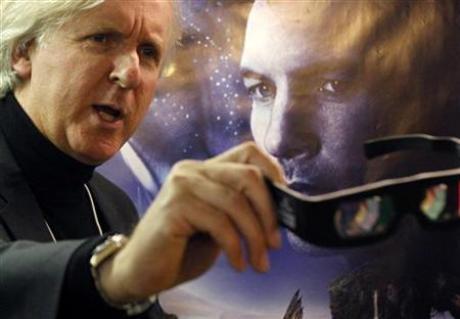


"Avatar" director James Cameron sees misguided thriftiness in Hollywood studios' latest craze to convert big movie projects from 2-D to 3-D, but the pace of such conversions shows no signs of letting up.
Cameron believes studios are rushing to take advantage of the public's appetite for 3-D films. But using computers to convert standard 2-D movies to 3-D, instead of filming in 3-D, gives audiences a cheaper-looking film and could do more harm than good if audiences get turned off.
He ought to know. Shot in 3-D, "Avatar" is the top-grossing movie of all-time with $2.7 billion at box offices.
And Cameron is not the only filmmaker questioning studios' headlong rush to convert films to 3-D, in a brewing battle that pitches major directors against the studios that employ them. "Transformers" maker Michael Bay has questioned the move, too.
"The problem is these decisions should be made by filmmakers, they shouldn't be made by studios, because if it was up to studios they're going to sacrifice quality for lower cost," Cameron said, in an event to promote the April 22 release of the DVD for "Avatar."
Studios are rapidly converting now that Walt Disney Co has seen its 3-D conversion "Alice in Wonderland" sell more than $570 million in tickets since its March 5 debut.
On April 2, Warner Bros, a division of Time Warner Inc, will release its action movie "Clash of the Titans" as another 2-D to 3-D conversion.
3-D FOR TENTPOLES
Warner Bros now plans to release all major "tentpole" movies in 3-D, Alan Horn, the studio's chief operating officer, told the movie theater convention ShoWest last week. He said "conversion to 3-D doesn't lessen" the experience of viewers.
Some estimates put the cost of a conversion as low as $5 million a film. Shooting in 3-D is far more expensive, industry watchers say, but difficult to determine because "Avatar" is one of the few live-action movies shot in 3-D.
It officially cost $237 million, although many reports have put the true expense over $300 million, and much of its cost was because new equipment created to make it.
Cameron said filmmakers "should have been pounding on the gates of the studios saying we want to make movies in 3-D."
"That didn't happen so now they're paying the price, which is a top-down studio cramdown telling them to make their movies in 3-D and they're caught with their pants down," he said.
"Transformers" director Michael Bay has also joined the debate, telling movie industry website Deadline.com this week that he is "not sold right now on the conversion process."
Film purists see conversions as lower quality because it can produce more of a layered look, with slightly less of a smooth and continuous depth perception.
But not all filmmakers are sold on shooting in 3-D, either. "Alice" director Tim Burton told reporters last month there was "no point" shooting his film in 3-D because it would have added one more wrinkle in an already complicated production.
"With all these tools, you can see good 3-D, bad 3-D, good conversion and bad conversions," he said.
Cameron himself plans to convert his 1997 blockbuster "Titanic" for a 3-D release in spring 2012, but he said that is different because he plans to take his time, instead of doing a "slapdash conversion."